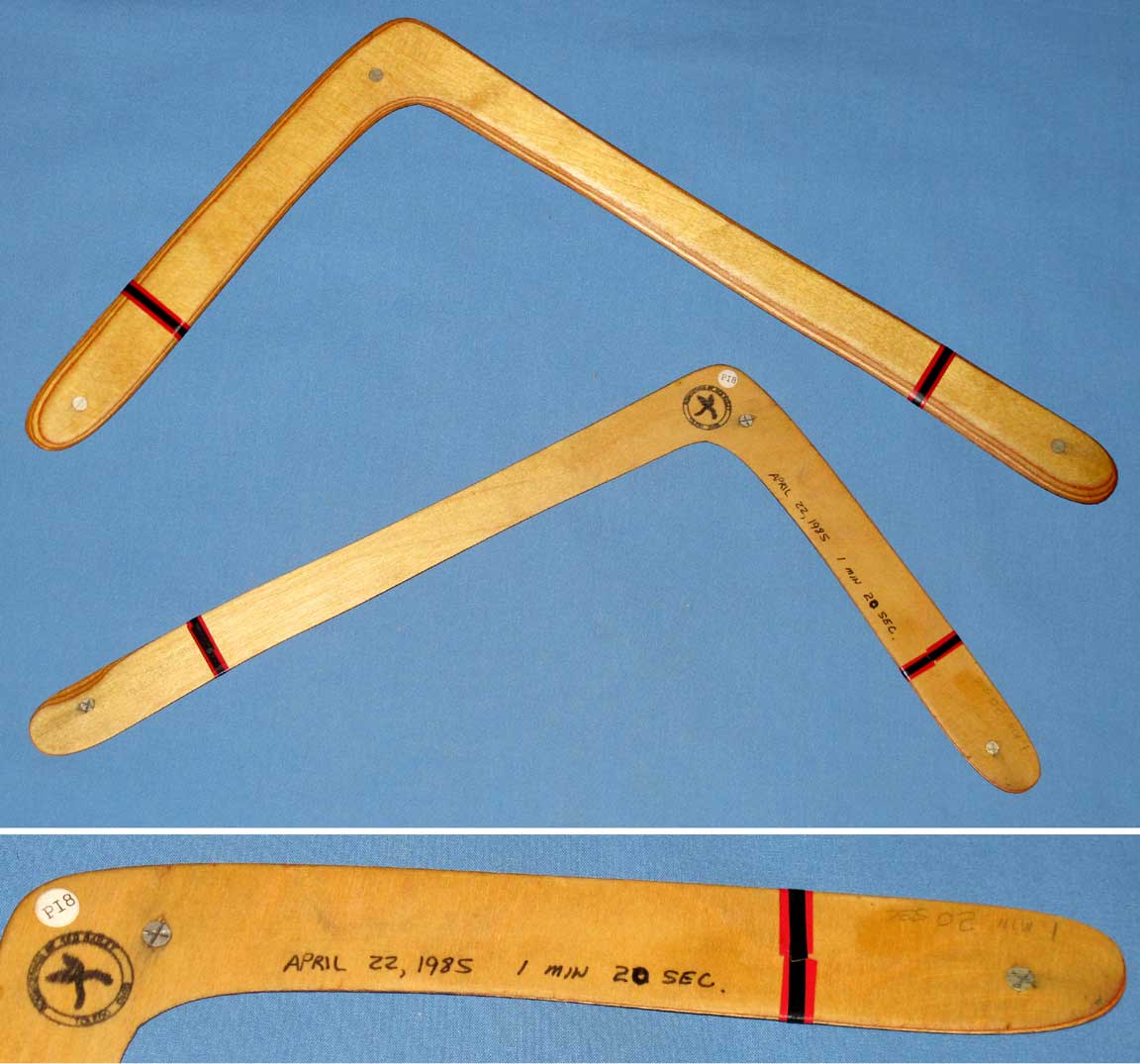Item PI8
This Item was Sold on 27 September 2024 for $125
Other collectable boomerangs for sale can be found on the Collectable Boomerangs link.
Historical Pricing information for this item and similar collectable boomerangs can be found on the Boomerang Pricing Guide
|
I developed my version of the Maximum Time Aloft (MTA) boomerang during the winter of 1984/1985. I read about this technology in the BBS Journal and through plans sent to me by Ben Ruhe. Ben's nephew, Barnaby Ruhe, had brought tracings of David Schummy's MTA designs when he returned home from Europe. Ben sent the plans to me but I did nothing with MTA until I went to the 1984 Challenge Match in Delaware, Ohio. I saw Peter Ruhf throwing his large MTA and getting flight times of 30+ seconds. Peter did not want any one to see what he was using, so he kept his MTA in a large sock in between throws. I saw enough of this hockey stick shape to start making my own MTA design which was completed in the Spring of 1985. My first flight exceeding 1 minute was done on 15 March 1985 using a very large model, about the same size as the Bretfeld and Ruhf designs. The flight on my large MTA was 67 seconds and I was able to achieve flights exceeding a minute on a regular basis. This was my Kitty Hawk moment. That first MTA did not have an accidental tuning or a lucky gust of wind. It was controlled flight by design and long flights were repeatable. After developing the large MTA model, I used an Engineering tool called Buckingham Pi to scale physical objects based on the ratio of primary forces, such as lift, drag and gravity. I had done something similar with full size sport boomerangs a couple of years earlier when I developed my line of Mini boomerangs. This MTA boomerang is the first Mini MTA and within a few minutes of tuning it on 22 April 1985, I achieved a flight of 80 seconds. This model later evolved into the famous Wind Sailor model that would take off and become a sacrifice to the Jet Stream God. Jonas Romblad developed the Wind Sailor into his marvelous composite MTAs. This first Mini MTA was made out of 2.6 mm Baltic Birch plywood. It has 3 lead weights, one in each blade tip and one in the elbow. There is only a single coat of Polyurethane on the top and bottom surfaces. I retired this boomerang after the historic flight and used it as my master copy for the development of future generations of Mini MTAs. I have not thrown this MTA since 1985 and it is in mint condition.
Ted Bailey is a retired Aerospace Engineer who has been making and throwing boomerangs since the early 1970s. The first boomerangs he marketed were multibladers sold on the C.S.U. Sacramento campus in the early 1970s. In the late 1970s, Ted sold traditional boomerangs at the West Palm Beach Mall. In the early 1980s, Ted moved to Ohio and started throwing in Ohio tournaments He developed a line of miniature boomerangs that performed well in competition. In the 1980s, new products included lap joint boomerangs made out of exotic woods and high performance competition boomerangs, especially Fast Catch and MTA. Ted was active in the USBA and served as Secretary, President and as a board member in the 1980s. He was the editor of the USBA newsletter, Many Happy Returns, for two decades and also produced two independent publications: Boomerang Journal and Boomerang News. Ted taught Flying Toy classes in several schools located in Ann Arbor, Michigan. Currently, Ted is retired and involved in internet marketing of boomerang products. |

How to Order | Back to: Boomerang Catalog | Collectable Boomerangs | Boomerang Pricing Guide | contact: Ted Bailey